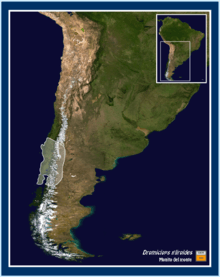Ixodes neuquenensis
| Ixodes neuquenensis | |
|---|---|
| Scientific classification | |
| Kingdom: | Animalia |
| Phylum: | Arthropoda |
| Class: | Arachnida |
| Subclass: | Acari |
| Order: | Ixodida |
| Family: | Ixodidae |
| Genus: | Ixodes |
| Species: | I. neuquenensis |
| Binomial name | |
| Ixodes neuquenensis Ringuelet, 1974 | |
 | |
| Range of Dromiciops gliroides, the host of Ixodes neuquenensis, in South America | |
Ixodes neuquenensis is a species of tick that lives on the monito del monte (Dromiciops gliroides), a nocturnal marsupial that lives in the northern temperate forests of southern South America.[1][2] Due to the near-threatened status of its host, Ixodes neuquenensis is also at risk.
Morphology
The females of Ixodes neuquenensis resemble other members of subgenus Ixodes but possess some distinct and notable morphological features. Two obvious spurs can be found on coxae II to IV. Two other species, I. theilerae from the Ethiopian ecozone and I. turdus from the Palaearctic ecozone, have two spurs on coxae II to IV as well but with differences in both shape and sizing. Female Ixodes neuquenensis also has very well-defined chitinous plaques on the alloscutum. Diagnostic features of the nymph of Ixodes neuquenensis include two spurs on coxae II to IV and the presence of chitnous plaques medial medial to coxae I. Though identification of the Ixodes neuquenensis larvae is more difficult, they can be separated from various other species by their triangular spurs on coxae II and III.[2]
The males of this species have yet to be described and remain unknown.
References
- ↑ G. V. Kolonin (2009). "Fauna of Ixodid Ticks of the World (Acari, Ixodidae)". Retrieved December 10, 2013.
- 1 2 Alberto A. Guglielmone; José M. Venzel; Guillermo Amico; Atilio J. Mangold; James E. Keirans (2004). "Description of the nymph and larva and redescription of the female of Ixodes neuquenensis Ringuelet, 1947 (Acari: Ixodidae), a parasite of the endangered Neotropical marsupial Dromiciops gliroides Thomas (Microbiotheria: Microbiotheriidae)". Systematic Parasitology. 57 (3): 211–219. doi:10.1023/B:SYPA.0000019082.96187.9c. PMID 15010595.